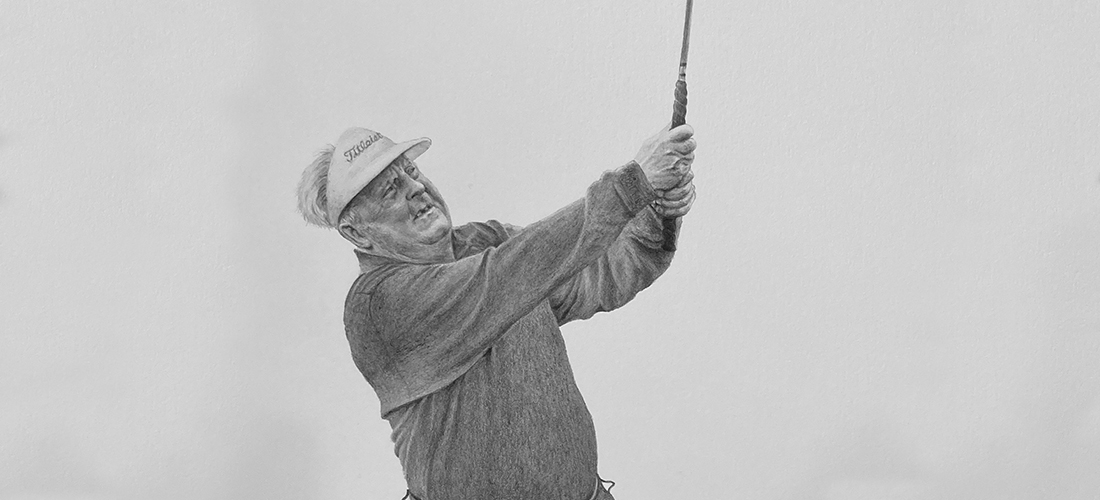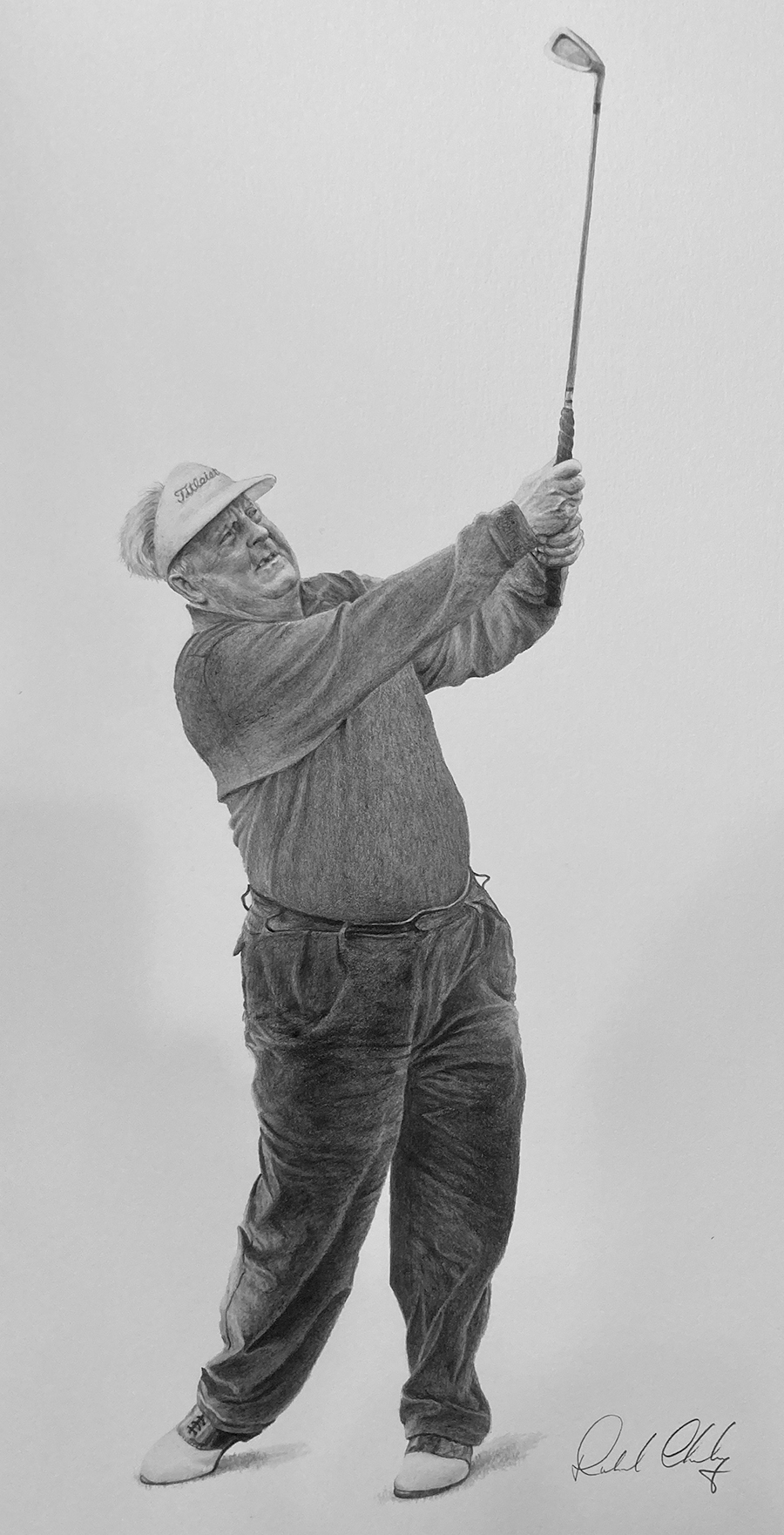
All About Moe
Sandhills links to a legend
By Lee Pace
It was a 20-hour drive from the outskirts of Toronto to the Florida coast town of Titusville, and dead in the middle of the drive was Pinehurst. Just as the goldfinch, sparrows and blue jays made their annual migrations in fall and spring from north to south and vice versa, so too did a curious little golf professional named Moe Norman.
Each April headed north and each October going south, Moe drove his Cadillac stuffed with golf clubs, shoes and balls and most of his worldly possessions off I-95 and ventured into the Sandhills, where he found friends, smiles and comfort at Pinehurst, Knollwood Driving Range and Pine Needles, and dropped in on village shops like Gentlemen’s Corner and Old Sport & Gallery.
“Moe was a remarkable guy,” says Eric Alpenfels, director of instruction at Pinehurst Resort and a young intern in the golf shop when he first met Norman in 1983. “He was a big history buff. I think he appreciated Pinehurst for its history. I think people in town made him feel welcome and comfortable. So every fall and every spring, you expected to get a call from Moe or just see him show up to hit balls.”
Norman was a crack Canadian golfer from the Toronto suburb of Kitchener who won back-to-back Canadian Amateurs in the late 1950s, played in the Masters, and in 1966 won five of the 12 Canadian Tour events he entered. Over his career, he shot three 59s, made 17 aces and nine double-eagles, and counted his course records at 41. But he never made a mark on the PGA Tour because with his childlike persona and eccentric ways (he routinely drank two dozen Cokes a day), he was uncomfortable in the fishbowl of tournament golf and nervous around strangers. He never sought psychological treatment, but when the movie Rain Man came out in 1988 with Dustin Hoffman portraying a middle-aged autistic man, many who knew him said, “That’s Moe.”
But he was a mythical figure among golf pros and had an insatiable appetite for hitting balls. He was so straight and so consistent he had the nickname Pipeline Moe.
“I don’t know of any player, ever, who could strike a golf ball like Moe Norman,” Lee Trevino once said. “If he had just had some sort of handler, manager, someone to handle his affairs, everyone would know the name today.”
Moe was short at 5 feet, 6 inches, liked pastel colors, often mixed plaids with stripes, and wore turtlenecks in warm weather. He often said things twice and with a noted up-lilt on the final syllable. He gripped the club in his palms with a wide stance and took what looked to be a three-quarters swing on one plane, ending not with a picturesque follow-through of a limberback but with his hands and club gyrating above his head à la Arnold Palmer. He liked to say he and Ben Hogan were the only golfers who took the clubhead straight down the line exactly 22 inches. He once said he played the same wooden tee for seven years.
The stories of his ball-striking are legendary.
Moe was playing an exhibition with Sam Snead and Porky Oliver at Toronto when they came to a par-4 with a creek crossing the fairway 240 yards out. Snead advised Norman against hitting his driver, saying, “This is a lay-up hole.”
“Not if you play for the bridge and run it across,” Moe said, and then did exactly that.
He once hit more than 1,500 drives in a seven-hour exhibition, all landing within a 30-yard-wide landing zone. “I wish we played 30-yard fairways and out-of-bounds,” he once said. “I’d be the only guy hitting driver.”
At other times he’d fire off dozens of piercing 4-irons in succession, pause and chirp to anyone listening, “Never off-line. This swing can’t hit it crooked.”
Once Moe spent several days being filmed hitting balls and giving instructional tips on drivers, fairway woods, long irons and wedge shots. The third morning, the producers planned to ask him about long-distance putting.]

“Moe, we want you to talk about lag putts, how to manage a 50- or 60-footer.”
Norman blew them off. “I never had one. Why would you want to be 50 feet away?”
If someone told him a hole was a “driver-wedge hole,” Moe was liable to hit a wedge off the tee and a driver into the green and say, “You’re right. Driver-wedge.”
Pat McGowan, the head of instruction at Pine Needles, was playing the PGA Tour in the 1980s when he first saw Norman give an exhibition at the Canadian Open.
“Ben Crenshaw, Greg Norman, Nick Faldo, the whole golf world would stop practicing and walk over and watch Moe hit balls,” McGowan says. “I remember the first time I saw him. He hit 25 or 30 straight drives. Every one of them carried over 220 yards and stayed in a 25-yard fairway. Moe smiled at everyone and said, ‘You want me to hit 50? I’ll stay all night.’”
Alpenfels was working the counter at the Pinehurst golf shop in 1983 when someone nodded to a little man and said, “That’s Moe Norman.” Alpenfels remembered the name from conversations with Jim Hardy, his mentor in California. Alpenfels struck up a conversation, watched Norman hit balls and developed a friendship. He was invited to Norman’s winter headquarters at Royal Oak Country Club in Titusville that year to hang out.
“Moe was a brilliant ball-striker,” Alpenfels says. “He virtually could do what he said he could do. If he told you that he was going to hit five drives in a row and that all would land within a 5-foot radius, he’d pretty much do that. He was amazing. From a ball-striking standpoint, it was crazy how good he was.”
Chris Dalrymple, owner of the Gentlemen’s Corner clothing store in the village, remembers Moe would “just appear out of nowhere, sort of like a genie,” and would look around the shop, never buying anything.
“I remember he wore two watches, one on each wrist,” Dalrymple says. “I asked him why he did that. He said, ‘I just do.’”
From Pinehurst, Norman would drive down Midland Road and visit another friend, Greg Gulka, the head pro at Knollwood, and then on to Pine Needles to hit balls with Peggy Kirk Bell and Jim Suttie, the head instructor there in the 1990s.
“The first time I ever saw Moe, he was hitting drivers out of divots,” says Kelly Miller, Mrs. Bell’s son-in-law. “He was rifling golf balls down the range, one after another. They came out of that divot like a rocket.”
Moe had money problems for most of his adult life, saying he “had slept in bunkers all across Canada.” He never had a credit card or a checking account. He refused Miller’s offer for a bed at Pine Needles but would accept several hundred dollars Miller would slip in his pocket after entertaining guests at Pine Needles with an exhibition. Some thought Norman spent most of his nights in his car, but he usually had enough funds for a Motel 6 or Super 8. His finances were buttressed significantly when he met Titleist CEO Wally Uihlein at the 1995 PGA Show. Uihlein watched Norman hit balls and said Norman was a national golfing treasure and allowed that Titleist would pay him a $5,000-a-month stipend for the rest of his life.
That lasted until September 2004, when Norman died of a heart attack.
“He had everything he needed. He had a good car, a place to stay and wonderful friends,” Alpenfels says. “He’d give you the shirt off his back if you needed it.”
A documentary film about Moe Norman’s life is in the works.
“It’s an underdog story. It’s a story about a guy who never should have succeeded, but did,” says Barry Morrow, the Oscar-winning screenwriter of Rain Man and a co-producer of the film.
“I think he wanted to be the best at something. And hitting a golf ball was it,” adds Suttie. PS
Lee Pace has written about golf in The Sandhills for three decades. His newest book, Good Walks — Rediscovering the Soul of Golf at 18 Top Carolinas Courses, will be available wherever you buy books.
His personal favorites include anything by P.G. Wodehouse. Tied for first are Heart of a Goof and Right Ho, Jeeves.





